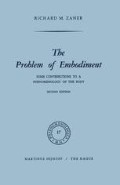Abstract
Unlike Sartre’s theory of the body-for-itself in his L’Etre et le Néant, it is not possible to submit Merleau-Ponty’s theory of the body-proper to a straightforward exposition and interpretation, following his major work1 step by step. Over and above the complexity of the theory itself, Merleau-Ponty’s analysis proceeds on a varity of levels which are not clearly distinguished by him. Moreover, when Merleau-Ponty makes use of other doctrines (as, for instance, those of Gestalt psychology, or those of Husserl), he has invariably transformed their meaning and reinterpreted them in terms of his own fundamental theory, but without letting his readers know of this in advance. In this way, certain fundamental notions (such as “form,” or “synthesis”), which have their own specific meanings in the contexts from which he takes them, are used in a quite different way by him, but with no indications that this transformation has occurred — and, indeed, within his own work itself, he does not always use the same term in the same way. The over-all result of this is an at times quite confusing amalgam of methods, analyses, and points of view.
Access this chapter
Tax calculation will be finalised at checkout
Purchases are for personal use only
Preview
Unable to display preview. Download preview PDF.
References
Phénoménologie de la Perception, Librairie Gallimard (Paris, 1945), 531 pp. (Hereafter citied textually as PP.)
Structure du Comportement, P.U.F. (Paris, 3rd edition, 1953), 248 pp.
W. Köhler, Gestalt Psychology, Liveright (New York, 1929), pp. 228–29.
Merleau-Ponty takes this point from Aron Gurwitsch, Recension du ‘Nachwort zu meinen Ideen,’ de Husserl, Deutsche Litteraturzeitung, 28 February 1932. See also, Gurwitsch La Théorie du Champ de la Conscience, Desclée de Brouwer (Paris, 1957), pp. 78–82.
Cf. also, PP, 25, where Merleau-Ponty interprets the unity of the object of perception as dependent upon this vague solicitation and, corresponding to it, a vague presentiment of the immanent unity of the object by consciousness. Cf. also Husserl, Erfahrung und Urteil, Ciaassen Verlag (Hamburg, 1954), pp. 79–80; and below, footnote, 2 p. 160.
Cf. de Waelhens, op. cit., pp. 391–92, and 402–08.
Cf. Gurwitsch’s presentation of this problem, Théorie du Champ…, op. cit., Parts I and II.
Cf. Husserl, “Philosophy as a Strict Science,” Cross Currents, Vol. vi, No. 3 (Summer, 1956), pp. 230–33.
Cf. de Waelhens, op. cit., p. 109.
Ibid., pp. 113–14.
Just this “en quelque manière” is the problem, as we shall see.
He thus accepts without question one of Sartre’s transformations of Husserl. See above, pp. 66–69.
Sartre, Situations, I, Gallimard (Paris, 1947), pp. 31–35. See above, Part II, Chapter I. pp. 59–80.
Cf. on this, PP, 491; and below, pp. 182–89.
J. H. Van Den Berg, The Phenomenological Approach to Psychiatry, op. cit., p. 32.
De Waelhens, op. cit., p. 386.
Cf. Cartesian Meditations, op. cit., pp. 18–21, 33–37; and Ideen, I, p. 94.
Richard Schmitt, “Husserl’s Transcendental-Phenomenological Reduction,” PPR, Vol. xx, No. 2 (December, 1959), p. 240.
Cf. Cartesian Meditations, op. cit., ibid., and Ideen, I, op. cit., pp. 56–57.
Cf. Cartesian Meditations, op. cit., p. 41.
Cf. above, footnote 4, p. 138; further references to this essay will be cited in the text as (Signes).
Ibid., p. 2.
Ibid., p. 4. For Merleau-Ponty, as we shall see, just this “ambiguity” becomes central to this theory.
Ibid., p. 132.
Ibid., pp. 4–8.
Merleau-Ponty refers here to Husserl’s use of “aesthetic,” as pertaining to sensuous experience: Formale und transzendentale Logik, op. cit., p. 257.
Rights and permissions
Copyright information
© 1971 Martinus Nijhoff, The Hague, Netherlands
About this chapter
Cite this chapter
Zaner, R.M. (1971). Introduction. In: The Problem of Embodiment. Phaenomenologica, vol 17. Springer, Dordrecht. https://doi.org/10.1007/978-94-010-3014-4_7
Download citation
DOI: https://doi.org/10.1007/978-94-010-3014-4_7
Publisher Name: Springer, Dordrecht
Print ISBN: 978-94-010-3016-8
Online ISBN: 978-94-010-3014-4
eBook Packages: Springer Book Archive

